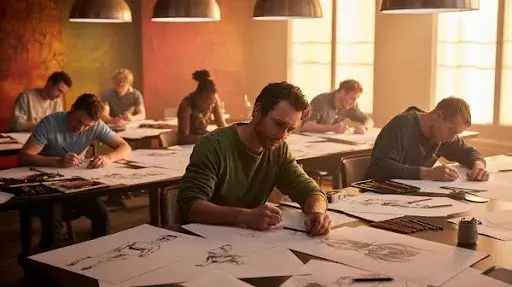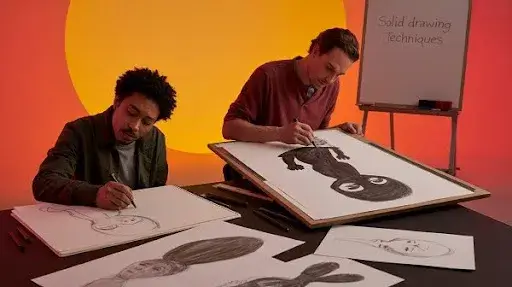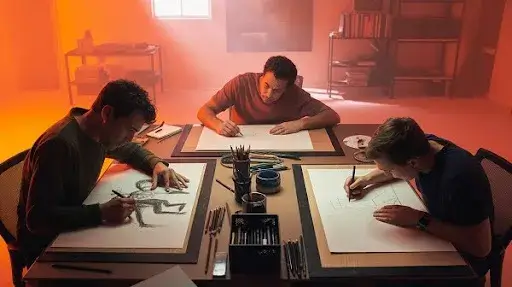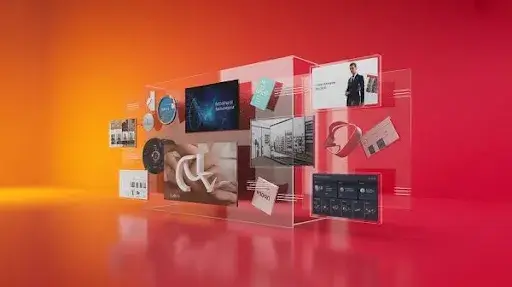Animation without a backbone doesn’t stand for long. You can set the scene, crank up the sound, add colors that dazzle, but if the characters themselves feel flat, the whole thing collapses. That’s why solid drawing animation matters so much. It gives characters weight, depth, and that believable presence that keeps viewers hooked.
Audiences may not stop and analyze why something looks off, but they feel it. A flimsy character, one that seems to float without gravity, immediately breaks the illusion. Solid drawing is the principle that keeps that from happening. It’s what makes a figure feel like it belongs in three-dimensional space, even when it’s just a pencil line on paper.
For anyone serious about animation, this principle isn’t an optional add-on. It’s the groundwork. Let’s dig into solid drawing in animation, why it matters, and what makes it a timeless skill for both 2D and 3D work.
What Is Solid Drawing in Animation?
At its core, it’s the skill of making a drawing look three-dimensional. It’s the difference between a lifeless doodle and a figure that looks like it could step off the page. Characters and objects feel like they have weight, volume, and a position in real space.
Disney’s animators first laid it out in the 1930s as one of the famous 12 principles of art in animation. And it hasn’t lost relevance. In fact, the more advanced the software becomes, the more valuable this old-school principle proves to be.
Think of solid drawing as the anchor between imagination and believable movement. You can push proportions, bend rules, exaggerate wildly—but if you don’t understand structure, the animation crumbles into flatness. It’s why the best animators, even in top 3D animation studios, still practice this principle every day.
The Core Elements Behind Solid Drawing Animation
Here’s where the principle breaks down into practical parts. Together, these elements form the real toolkit:
Form in Solid Drawing Animation
Every design starts simple. Cubes, cylinders, spheres—these are the building blocks. Animators reduce complex characters to these forms before adding detail. If you can spin those shapes around in your head and draw them from any angle, you’ve got control over structure.
Form also influences how we react emotionally. Rounder shapes tend to look friendly. Sharper, angular designs give off danger. That’s why many animation characters to draw are first blocked out with clear, simple 3D-like forms.
Volume and Weight
Volume gives drawings their physical presence. Without it, characters look like cutouts taped on a background. With it, they feel planted. Shading, overlaps, and perspective cues turn a line drawing into something with mass.
Weight takes it further. A character’s steps push against the ground, arms swing with believable force, and bodies bend under gravity. Watch good, solid drawing animation examples, and you’ll notice how weight sells the motion.
Proportions and Structure
Stylization is part of animation’s charm, but even exaggeration needs rules. Proportions keep things consistent. A head that’s too large or an arm that changes length frame to frame destroys immersion.
Even in 2D video animation, proportions guide how characters relate to their environment. They form the math beneath the art, the invisible structure that holds everything together.
Perspective and Space
Perspective ties the character to the setting. Horizon lines, vanishing points, foreshortening—these techniques make figures feel like they’re standing in the same world as the background.
Think of a hand reaching toward the viewer. Done wrong, it’s flat and awkward. Done right, it feels like the hand is popping out of the frame. That’s why fundamentals of perspective still matter, even when digital tools are involved.
Shape Language and Silhouette
The outline tells its own story. A strong silhouette makes a pose readable in an instant. Audiences catch shapes first, details later.
Sharp, jagged silhouettes give energy and aggression. Smooth, flowing outlines suggest softness or charm. This is where the solid drawing animation principle overlaps with design language. Every shape speaks. And when shapes are clear, animators save themselves headaches during motion sequences.
Techniques to Strengthen Solid Drawing in Animation
This isn’t a skill you pick up overnight. It’s built through habits and repeated practice. Here are methods that animators swear by:
Line of Action
The line of action is that invisible flow running through a character’s posture. It gives energy, rhythm, and intent. Skip it, and your poses stiffen. Use it well, and your drawings come alive with motion.
Turnarounds
Want to test if you understand your design? Spin it around. Drawing turnarounds—characters seen from the front, side, back, and in-between—forces consistency. If the form holds up at every angle, you’ve nailed the structure.
Life Drawing Practice
Few exercises sharpen the eye like sketching real people. Quick gesture sketches capture posture and balance in seconds. Longer studies dig into anatomy and weight distribution. For honing animation solid drawing, and life drawing remains unbeatable.
Light and Shadow Studies
Light reveals mass. Playing with side lighting, top lighting, or rim lighting teaches how to carve depth out of flat lines. Even in stylized projects, smart use of light and shadow is what makes figures feel planted.
Reference and Observation
Mirrors, video clips, photos—animators use them constantly. Observing how a body bends, how fabric folds, or how an object tilts adds truth to animation.
Even exaggerated animated cartoons start from reality. That layer of observation keeps movements from looking mechanical.
Benefits of Mastering Solid Drawing Animation
So why does all this matter? Because solid drawing changes how animation looks and feels:
- Complex Motion: You can tackle foreshortening and wild poses with confidence.
- Exaggeration with Control: Stretching and squashing become intentional choices, not mistakes.
- Readability: Clear silhouettes keep actions easy to read.
- Weight and Bounce: Characters stop floating and start feeling physical.
- Performance and Expression: Proportions and shapes help amplify subtle acting.
- Consistency: Characters don’t drift or warp across frames.
That’s why professional animators treat it as essential. Solid drawing is what separates a rough sketch from animation that feels alive and convincing.
Importance of Solid Drawing Animation in the Digital Era
Many people still believe that solid drawing was only useful when everything was hand-drawn. That idea doesn’t hold up. Even with motion capture, complex rigs, and advanced 3D tools, this principle keeps resurfacing.
Here’s the truth: software can help with perspective, but it can’t give a character believable weight or balance. If the animator doesn’t understand form, the performance falls flat. That’s why solid drawing animation remains at the center of great work, no matter how modern the pipeline looks.
Studios know it too. Many 3D animation companies still push their new hires to sketch and practice figure drawing before touching Maya or Blender. It’s not about clinging to the past. It’s about giving artists the instincts to make characters move like they belong in their own space.
Common Mistakes Beginners Make with Solid Drawing
Learning solid drawing comes with a few traps. Some of the big ones:
- Skipping the line of action: characters feel stiff and lifeless.
- Getting into details too early: the pose loses structure before it even takes shape.
- Forgetting light and shadow: everything looks flat, almost like cardboard cutouts.
- Messy proportions: heads, arms, or legs shift size from frame to frame.
- Weak silhouettes: the pose doesn’t read at a glance.
Fixing these mistakes takes repetition. The good news? Once you nail them, you’ll see a noticeable jump in the quality of your animation.
How Pros Use Solid Drawing Day-to-Day
Solid drawing isn’t something you tick off like a to-do item. It runs through the entire process:
- In pre-production, character designers set up turnarounds with forms, balance, and clear silhouettes.
- In storyboards, figures get broken down into bold shapes and strong lines of action.
- During key animation, the principle drives how characters move between main poses.
- Even in clean-up, it shows up—artists check volumes, proportions, and balance frame by frame.
So, from first sketch to polished shot, solid drawing in animation holds everything together. It’s the steady hand that keeps characters from looking floaty or inconsistent.
Solid Drawing and Character Animation
Think about animated icons—Disney heroes, Pixar leads, even stylized 2D favorites. They all share one thing: they feel solid. You trust their weight and form, no matter how exaggerated the performance gets.
That’s the beauty of this principle. Take squash-and-stretch, for example. Done without structure, it looks sloppy. Done with solid drawing, it works beautifully because the character still has believable mass underneath.
For anyone working in character animation, this skill is a must. It’s what lets a slight shrug, a small head tilt, or a slow hand gesture carry emotional meaning. That subtlety can only land if the underlying drawing feels anchored.
Frequently Asked Questions
What is the solid drawing principle in animation?
It’s one of Disney’s 12 principles. The idea is to keep characters looking three-dimensional, balanced, and weighty, no matter the style.
Why does solid drawing matter in 3D animation?
Software helps with perspective, but it can’t replace an understanding of form. Solid drawing helps animators create stronger poses that move naturally.
How do I practice it?
Life drawing, gesture sketches, breaking figures into basic 3D shapes—cubes, cylinders, spheres. Add light and shadow studies, and you’ll see improvement fast.
Where can I find solid drawing animation examples?
Classic Disney films are full of them. So are many modern 2D shows and Pixar movies. Watch how weight, balance, and silhouette stay consistent even in extreme poses.
Does it matter for motion graphics or explainer videos?
Yes. Even in stylized motion design, clear silhouettes and believable weight make visuals much easier to read.
Final Word
Solid drawing doesn’t scream for attention. It’s quiet but powerful—the thing that separates stiff animation from performances that feel alive. Without it, characters float. With it, even wild exaggerations feel grounded.
For animators aiming for mastery—whether in 2D video animation or high-end 3D animation studios—this principle isn’t optional. It’s what gives your characters spark and keeps your work professional.
And if you want your project handled by a team that takes these fundamentals seriously, Prolific Studio, one of the best animation studios in Houston, is ready. We combine artistic skill with technical know-how so your animation isn’t just polished—it feels alive.
Related articles:









